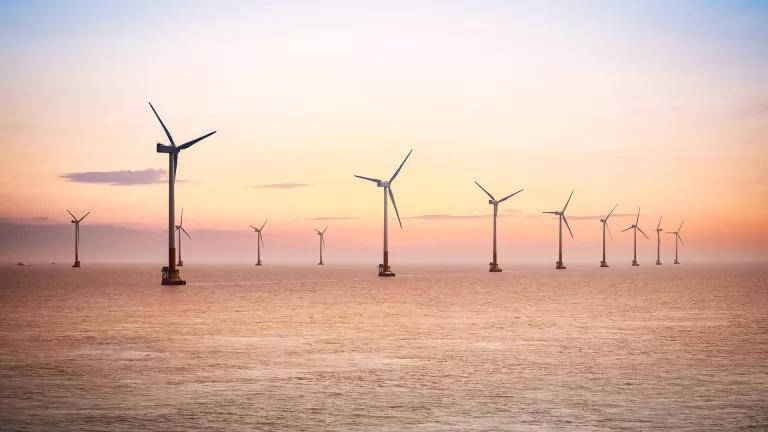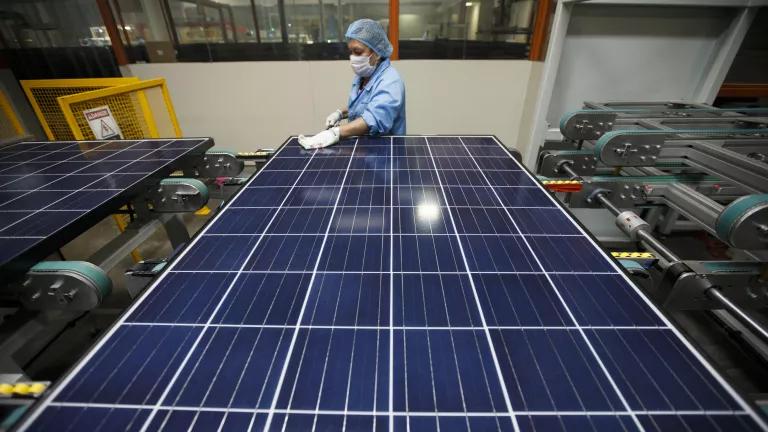Study Shows Value of Coordinated Offshore Wind Planning
Offshore wind energy promises to be a key component of our clean energy future.

It isn’t every day we get an opportunity to create a piece of the energy system from scratch. Yet that’s just where we find ourselves with respect to offshore wind. Dozens of U.S. offshore wind energy projects in the pipeline will require large transmission lines buried under the ocean floor and significant upgrades to the onshore grid. This new transmission network will be critical to decarbonizing our electric grid while also increasing its reliability. Unfortunately, identifying and planning for cost-effective solutions to bring that power ashore and get it to homes and businesses has lagged. However, there is still time to guide this process with a coordinated, proactive approach.
Coordinated planning for offshore wind will significantly reduce costs and environmental and community impacts, increase grid reliability, and improve the odds of achieving climate and clean energy goals quickly, according to a new report from The Brattle Group on behalf of NRDC, American Clean Power Association (ACP), the American Council on Renewable Energy (ACORE), the Clean Air Task Force (CATF), and GridLab. Absent an urgent, collaborative planning effort, offshore wind construction may face years of delays, billions of dollars in added costs, and excess construction through coastal habitats and communities just to build a patchwork system rather than a streamlined one.
While the U.S. has lagged behind Europe in the deployment of offshore wind, we’re catching up. The Biden Administration has set a goal of developing 30 GW of offshore wind power by 2030, enough to power over 22 million homes, and 110 GW by 2050. Meanwhile, 11 coastal states have set procurement targets of 50 GW through 2035 and over 75 GW by 2045. Overall, between 220 and 460 GW of offshore wind are likely needed by 2050 to meet U.S. clean energy goals. Integrating so much power into our existing grid presents a major policy and infrastructure challenge and will require unprecedented coordination between states, federal agencies, and regional grid operators.
Meeting this challenge will require complex infrastructure buildouts and careful coordination with grid operators and regional transmission organizations. Proactive planning can streamline the process, accelerate the development of offshore wind, create jobs, and prevent duplication that wastes precious time and financial resources.
It’ll be worth the effort. Collaborative transmission planning for over 100 GW of offshore power is estimated to deliver the following benefits over the next two to three decades, according to the Brattle report:
- At least $20 billion in transmission-related cost savings
- 60-70% fewer shore crossings and necessary onshore transmissions upgrades
- Approximately 50% fewer miles of marine transmission cable installations disturbing the seabed
- More competitive procurement outcomes
- Increased consumer savings
- Enhanced reliability and grid resilience, and
- More timely investments in the local clean energy economy
The case for launching a new planning effort is clear, but the path forward is not.
Transmission lines typically take at least a decade to plan and build, meaning that any actions taken today will likely not result in working transmission lines until around 2035. Conversely, if we continue on our current path where states plan lines independently, we will lock ourselves into a redundant, inefficient system. Early projects may wind up monopolizing transmission corridors and interconnection points, potentially making it more difficult and more expensive for future projects.
Federal leadership, regional transmission operator input, and state buy-in are needed soon. These stakeholders should come together to map transmission corridors and grid interconnection points that will help us reach more ambitious longer-term goals. Early action will also put projects in line for tax credits for offshore wind generation and transmission, funding that may not be available if planning efforts are delayed.
Despite the barriers – slow interconnection processes, poorly defined transmission tariffs, and a legacy of siloed planning – there are steps we can take. Recommendations in the Brattle report include the following:
- Increase staffing and budgets in state and federal regulatory agencies
- Identify – or create – multi-state decision-making bodies
- Provide IRS guidance regarding the applicability of the investment tax credit to offshore wind-related interconnection facilities
- Stakeholders, including states, grid operators, and transmission owners, should begin planning feasible, cost-effective interconnection points now
- States should develop an actionable cost allocation framework that covers their offshore wind commitments within each region
- Improve RTO and interregional transmission planning
Thankfully, there are signs that a collective approach is emerging. Recently, Northeast states issued a Request for Information seeking comments on how to collaboratively plan to integrate significant amounts of offshore wind power into their regional grid. At the federal level, the Department of Energy is examining transmission options to support offshore wind development along the East Coast through 2050. The results of this study are expected to be released in late 2023.
These are encouraging steps, but more needs to be done. Offshore wind energy promises to be a key component of our clean energy future. Planning today to optimize the buildout in a way that minimizes costs and environmental impacts will ensure that we can turn this promise into a reality.



